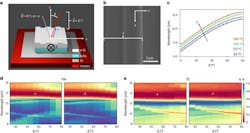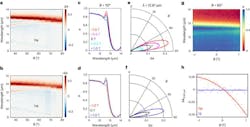Researchers Poke a Hole in Kirchhoff’s “Other” Law—or Maybe Not
What you’ll learn:
- What Kirchhoff’s “thermal law” is and why it’s important.
- How researchers have determined that the law breaks down in some circumstances.
- Why others disagree with those findings.
Engineers of all disciplines and especially electrical engineers are familiar with Kirchhoff’s voltage and current laws (promulgated in 1847). They quantify how voltage varies around a loop in a circuit and how current flows through a circuit. Though obvious to us, they were critical and insightful revelations at the time.
Kirchhoff’s Voltage Law (KVL) states that “the sum of the voltage differences around any closed loop in a circuit must be zero” (conservation of energy) while his Current Law (KCL) says that “the sum of the voltage differences around any closed loop in a circuit must be zero” (conservation of charge). The two laws are used extensively and almost subconsciously, as they’re at the foundation of system and circuit design and analysis.
But Gustav Kirchhoff did not stop with these laws. This German physicist also contributed to the fundamental understanding of spectroscopy as well as black-body energy radiation and absorption. The latter is a concept to which he contributed (he coined the term “black body”), and it was critical to the development of quantum theory in the early 1900s.
He developed his thermal law in 1860, which states absorptive and emissive efficiencies are equal at each wavelength and angle of incidence (more explanations of Kirchhoff’s thermal law can be found in the References section below). It’s roughly analogous to the reciprocity principle for antennas.
Decoupling Absorbed and Emitted Efficiency
Now, a team based at the California Institute of Technology (Caltech) has devised a device that they say breaks this normally tight relationship between the absorbed and emitted efficiencies of an object. The invention may also have important implications for sustainable energy-harvesting systems.
Why try to decouple the two? For example, if an energy-harvesting object such as a photovoltaic source (solar panel) is re-emitting some of its absorbed energy back toward the energy source (the Sun) as heat, that energy is lost to other uses. In theory, if the photovoltaic source—or other energy-harvesting object—were to re-emit absorbed radiation away from the source and toward yet another energy-harvesting object, the system could reach higher energy-conversion efficiencies.
The Caltech study shows that it’s possible to “break” the equality of Kirchhoff’s law of thermal radiation with a device placed in a moderate magnetic field. The device itself combines a material featuring a strong magnetic-field response with a patterned structure that enhances absorption and emission in infrared wavelengths (Fig. 1).
1. Schematic of magnetically tunable emission and absorption of GMR structure coupled to n-InAs and comparison of zero-field absorptivity and emissivity: Schematic of the GMR structure on InAs—the GMR structure has a grating periodicity Λ of 5.50 μm, groove depth of 0.50 μm and slab depth of 1.55 μm (a). In the case of no applied magnetic field, the absorptivity and emissivity channels are equal (left side, grey arrow). When a transverse magnetic field is applied along the z direction, the absorptivity and emissivity (red and blue arrows, respectively) are tuned away from being equal in the same channel to being equal in opposite channels. The grating periodicity Λ is confirmed with scanning electron microscopy images (b). Experimental data (points) of the +first-order guided-mode branch through absorptivity (24 °C, black) and emissivity (50, 100 and 150 °C; blue, green and red, respectively) measurements; the curves represent theoretical calculations (c). The red shift in the GMR for a given θ is a consequence of shifts in the refractive indices of a-Si and n-InAs as a function of temperature. TM-polarized (d) and TE-polarized (e) emissivity and absorptivity measurements taken at 100°C (left and right, respectively), showing the guided-mode dispersions.
Measuring the Emissivity-Absorptivity Inequality
The situation is complicated. Their experimental measurement of an inequality between the thermal emissivity and absorptivity for a photonic structure supports a transverse magnetic guided-mode resonance (dubbed GMR, but not to be confused with giant magnetoresistance) coupled to a magneto-optic material.
This inequality occurs under the application of an in-plane magnetic field that changed the permittivity of the magneto-optic indium arsenide (InAs) to a non-diagonal tensor. The non-diagonal permittivity tensor resulted in an antisymmetric angular relationship in which the magnetic tuning of stronger thermal emission for a given angle of incidence correlates to stronger absorption in the opposite channel.
Using an angle-resolved thermal emission spectroscopy (ARTES) arrangement (Fig. 2) they observed that the Kirchhoff-violating behavior was most pronounced where the GMR and the InAs’ Brewster-mode spectrally overlap (12.8–12.5 µm) over an angular range of 60 to 80 degrees (Fig. 3). [Note: Brewster's angle (also known as the polarization angle) is an angle of incidence at which light with a particular polarization is perfectly transmitted through a transparent dielectric surface, with no reflection.]
But wait…there’s more to this story. The work was reported in their paper “Direct observation of the violation of Kirchhoff’s law of thermal radiation” published in Nature Photonics, along with a Supplementary Information file. However, soon after it was published, two authors from academia and commercial interests posted a one-page rebuttal “Why Kirchhoff’s Law of Thermal Radiation Has Not Been Violated” at OSF/Center for Open Science site. Scientific disputes of this type aren’t unusual (it happened with quantum physics, relativity, and even heliocentricity), but they’re still noteworthy.
What’s the Takeaway?
My take on this claim by these researchers is multifaceted. I certainly don’t have the advanced physics background needed to fully assess their claims of the Caltech researchers. I do know that when materials are subject to extreme conditions—here, a magnetic field—conventional principles may bend and break. Think of the effects of ultra-low temperatures (cryogenics) or ultra-high ones (plasma states) on materials.
In addition, this linking of the apparent violations of Kirchhoff’s thermal law to solar panels and photovoltaic efficiency has some aspect of using what marketing folks call “borrowed interest” to gain attention.
It seems that nearly every research project I read about these days—and I read summaries of lots of them—claims some connection, however tenuous, with climate change, CO2 emissions, sustainability. carbon footprint, and similar themes. Perhaps the reason for all of this keyword connectivity is perhaps that’s where the bulk of the all-important grant funding and public-relations attention is focused these days.
References
SPIE, “Kirchhoff's Law and Emissivity”
Caltech, “Radiative Transfer”
Wikipedia, “Kirchhoff's law of thermal radiation”


![2. For emissivity measurements, the sample is mounted on a heater at the rotation axis of a goniometer [a device that measures an angle or permits the rotation of an object to a definite position], centered between the pole pieces of an electromagnet (a). The goniometer allows for rotation of the sample around the z-axis and probes the outgoing radiation at an angle θ. The sample emission is collected through a zinc-selenide (ZnSe) lens and sent through an external port into an Fourier transform infrared (FTIR) spectrometer. A polarizer is placed in front of the detector to resolve the TM and TE emission. The absorptivity measurement system uses an FTIR source and detector mounted on a 2-θ rotation stage (b). Instead of an electromagnet, a Halbach array of permanent magnets [a special arrangement of permanent magnets that augments the magnetic field on one side of the array while canceling the field to near zero on the other side] to apply the magnetic field. The sample is still heated to the same temperatures as in the emissivity measurements so that there can be a direct comparison of the absorptivity and emissivity as defined by Kirchhoff’s Law. 2. For emissivity measurements, the sample is mounted on a heater at the rotation axis of a goniometer [a device that measures an angle or permits the rotation of an object to a definite position], centered between the pole pieces of an electromagnet (a). The goniometer allows for rotation of the sample around the z-axis and probes the outgoing radiation at an angle θ. The sample emission is collected through a zinc-selenide (ZnSe) lens and sent through an external port into an Fourier transform infrared (FTIR) spectrometer. A polarizer is placed in front of the detector to resolve the TM and TE emission. The absorptivity measurement system uses an FTIR source and detector mounted on a 2-θ rotation stage (b). Instead of an electromagnet, a Halbach array of permanent magnets [a special arrangement of permanent magnets that augments the magnetic field on one side of the array while canceling the field to near zero on the other side] to apply the magnetic field. The sample is still heated to the same temperatures as in the emissivity measurements so that there can be a direct comparison of the absorptivity and emissivity as defined by Kirchhoff’s Law.](https://img.electronicdesign.com/files/base/ebm/electronicdesign/image/2023/10/ED_interest_Kirchhoff_thermal_law_Fig2.652d85802fd07.png?auto=format,compress&fit=max&q=45&w=250&width=250)
